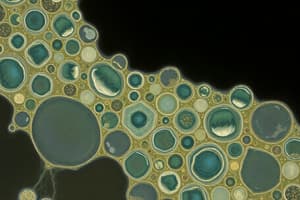Podcast
Questions and Answers
Who discovered the cell?
Who discovered the cell?
Robert Hooke
What is the plasma membrane's function?
What is the plasma membrane's function?
Separates the cytoplasm from the outside environment and is semipermeable.
What does the cytoplasm contain?
What does the cytoplasm contain?
Gel-like fluid that maintains an optimal environment for cellular organelles.
What do ribosomes do?
What do ribosomes do?
What are plasmids used for?
What are plasmids used for?
Which of the following structures is involved in cell motility?
Which of the following structures is involved in cell motility?
All living things are composed of one or more cells.
All living things are composed of one or more cells.
Which of the following organelles is known as the powerhouse of the cell?
Which of the following organelles is known as the powerhouse of the cell?
The process of synthesizing proteins following the instructions of the nucleus is performed by the ______.
The process of synthesizing proteins following the instructions of the nucleus is performed by the ______.
Match the following organelles with their primary functions:
Match the following organelles with their primary functions:
What unique organelle is found in plant cells that contains chlorophyll?
What unique organelle is found in plant cells that contains chlorophyll?
Flashcards are hidden until you start studying
Study Notes
Cell Discovery and Key Contributors
- Robert Hooke discovered the cell.
- Anton Van Leeuwenhoek studied microscopic organisms, referred to as animalcules.
- Matthias Schleiden identified the presence of plant cells.
- Theodor Schwann recognized animal cells.
- Rudolf Virchow proposed that new cells arise from existing cells, aligning with non-spontaneous generation.
Postulates of Cell Theory
- Living organisms are composed of one or more cells.
- The cell functions as the fundamental unit of life.
- New cells originate from pre-existing cells.
Plasma Membrane
- Separates cytoplasm from the external environment.
- Functions as a semipermeable barrier, regulating the entry and exit of substances.
Cytoplasm
- Gel-like fluid that supports and maintains the optimal environment for cellular organelles.
Ribosomes
- Tiny spherical organelles responsible for protein synthesis.
Plasmid
- Small DNA molecules that carry non-essential genes.
- Useful in genetic engineering for gene amplification.
Pili
- Hair-like structures that facilitate motility and adherence to surfaces.
Flagellum
- A structure that enables motility for cells.
Nucleoid
- Contains DNA and regulates growth, reproduction, and function in prokaryotic cells.
Similarities Between Prokaryotic and Eukaryotic Cells
- Both types contain cell wall, plasma membrane, cytoplasm, ribosomes, and DNA.
- Some prokaryotic cells possess flagella for movement.
Prokaryotic Cell Structures
- Capsule: A sticky outer layer made from polysaccharides, providing protection.
- Cell Wall: Maintains cell shape and protects the inner contents.
Eukaryotic Cell Features
- Plasma Membrane: Controls molecule passage and offers protection.
- Cytoplasm: Medium for chemical reactions, containing organelles.
- Nucleus: The 'brain' of the cell, housing genetic material (DNA).
- Mitochondria: Known as the 'powerhouse', they produce ATP.
- Golgi Body: Modifies, packages, and exports proteins.
- Lysosome: Acts as the digestive center, breaking down waste materials.
- Vacuole: Stores water and waste; in plants, it can occupy over 30% of the cell's volume.
- Cytoskeleton: Provides shape and mechanical support, especially during cell division.
Unique Organelles in Plant Cells
- Chloroplast: Contains chlorophyll for photosynthesis, converting sunlight to sugars.
- Amyloplast: Storage center for starch granules.
- Cell Wall: Offers rigidity and protection from mechanical stress.
Unique Organelles in Animal Cells
- Centrosome: Produces microtubules essential for cellular structure.
Studying That Suits You
Use AI to generate personalized quizzes and flashcards to suit your learning preferences.




